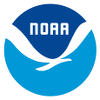| NOAA/GLERL is not an operational center. We make every effort to ensure accuracy and minimize downtime, however, we cannot guarantee that data and products will always be available and/or accurate. Our forecasts and products should be considered experimental. Please review our disclaimers. |
Experimental Biophysical Forecast for Lake Huron CSMI 2022
Click here to see archived biophysical nowcasts/forecasts for Lake Michigan CSMI 2020 and 2021.
Pinch (two-finger) zoom in/out of the maps on mobile, Ctrl +/- on desktop
These animations provide estimates of the transport of river inputs by currents in Lake Huron, and contribution to phytoplankton biomass (chlorophyll-a). This information is intended to support field researchers during the 2022 Lake Huron Coordinated Science and Monitoring Initiative (CSMI). The model consists of a phosphorus-limited lower food web, with state variables representing dissolved phosphorus, phytoplankton, zooplankton, and detritus (Rowe et al., 2017). Dreissenid mussels are not included in these simulations. Dissolved organic carbon (DOC) is simulated as a tracer for river input, with a slow decay rate. River inputs of water, temperature, dissolved phosphorus, particulate phosphorus, and DOC are included at 96 locations in Lake Huron. The model simulations are updated daily, and provide a 24 hour nowcast and a three-day forecast.
Data on currents are obtained from NOAA's Lake Michigan-Huron Operational Forecast System (LMHOFS).
LMHOFS is an application of the Finite Volume Community Ocean Model (FVCOM).
River discharge data are obtained from:
USGS National Water Information System and
Environment and Climate Change Canada Real-time Hydrometric Data web site.
Reference: Rowe, M. D., Anderson, E. J., Vanderploeg, H. A., Pothoven, S. A., Elgin, A. K., Wang, J., Yousef, F. (2017). Influence of invasive quagga mussels, phosphorus loads, and climate on spatial and temporal patterns of productivity in Lake Michigan: A biophysical modeling study. Limnology and Oceanography, 62(6), 2629-2649. https://www.glerl.noaa.gov/pubs/fulltext/2017/20170018.pdf
Tributary total and dissolved phosphorus mean concentrations were estimated from data associated with the following publications:
- Saad, D.A., Benoy, G.A., and Robertson, D.M., 2018, Estimates of long-term mean-annual nutrient loads considered for use in SPARROW models of the Midcontinental region of Canada and the United States, 2002 base year: U.S. Geological Survey Scientific Investigations Report 2018–5051, 14 p., https://doi.org/10.3133/sir20185051
- Robertson, D.M., and Saad, D.A., 2019, Spatially referenced models of streamflow and nitrogen, phosphorus, and suspended-sediment loads in streams of the Midwestern United States: U.S. Geological Survey Scientific Investigations Report 2019–5114, 74 p. including 5 appendixes https://doi.org/10.3133/sir20195114
Tributary DOC concentrations were estimated using a relationship of DOC~Wetland% of watershed reported in the following publication:
- Berg, S. M., Mooney, R. J., McConville, M. B., McIntyre, P. B., & Remucal, C. K. (2021). Seasonal and spatial variability of dissolved carbon concentration and composition in Lake Michigan tributaries. Journal of Geophysical Research: Biogeosciences, 126, e2021JG006449. https://doi.org/10.1029/2021JG006449
The Great Lakes Hydrography Dataset provided landuse data for Lake Huron's watershed as reported in this publication:
- Forsyth, D. K., Riseng, C. M., Wehrly, K. E., Mason, L. A., Gaiot, J., Hollenhorst, T., . . . Whelan, G. (2016). The Great Lakes Hydrography Dataset: Consistent, Binational Watersheds for the Laurentian Great Lakes Basin. JAWRA Journal of the American Water Resources Association, 52(5), 1068-1088. https://doi.org/10.1111/1752-1688.12435
General Inquiries:
oar.glerl.www@noaa.gov
(734)741-2235
Data Inquiries:
oar.glerl.data@noaa.gov


